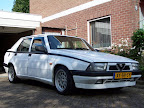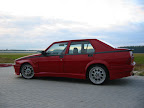This really seldom piece from Denmark was to become unique after it's overhaul.
Just a few words about the Standard-Evoluzione:
The Evo distinguishes itself through following details from the "normal" Alfa 75 Turbo
Limited series of only 500. All were built in the spring of 1987
Only delivered in red
Front-grill was not in grey, but in red
6x15" Rims instead of the 14" rims, coloured red
Stickers on the side with grey background and black text "75 Turbo Evoluzione"
Wings were widened, side panels, front-spoiler and bumper all made from super-light GFK (according to Alfa the Cd-value was down from 0,38 to 0,33. The Evoluzione was the first 75'er with the small rear-spoiler, which was later used in the serie version).
Seat design was slightly altered
Stiffer springs and even stiffer suspension units
Thicker rear-stabilizer (from 21mm up to 27,5mm)
Larger wheel-bearings front & rear
Redesigned "uprights" and front axle geometry
Exhaust-manifold with two-piece exhaust
Redesigned turbo
Strengthened main-bearings
Strengthened cylinder block
Strengthened cylinder head
Pistons which are 0,4 mm smaller, this then gives a cubic capacity of 1762 ccm. The standard from Alfa 75 Turbo is 1779 ccm. These measures were taken because the Evo was to drive in the group A (up to 3 Litre cubic capacity). For the classification of the turbo engines is the conversion factor 1,7. By 1762 ccm this would give us 2995,4 ccm. With the series bore this would have given the Evo 24 ccm more than legally allowed.
The following modifications were made to this Evo:
Quality spray job with 3-layer varnish finish
Dark grey window frames
8x17" BBS 3-piece rims
215/40-17 Goodyear Eagle F1 tyres
Lower rear springs
Strengthened stabilizers up front (70% stiffer)
Negative camber up front
Casterarm with ball-joint in the front wheel mounting
Shock absorbers (original Spica Evo) changed to yellow Koni
ATE Powerdisc disc-brakes up front. Mintex 1144 brake-pads front & rear
Recaro-seats and interior from the 75 Limited Edition (only 5.000 produced)

Electronic anti-theft device
Sony Radio with CD-player, 4 piece 3-way speakers and remote-control
Momo Zagato steering-wheel from the Alfa SZ

Turbo exchanged from the Garrett T3 to a hybrid Garrett GT25R with 360 deg. bearing and superlight kompressor wheel
3" Turbo exhaust-pipe
Supersprint exhaust system
New pressure-box (Inlet-manifold)
EFI Technologies engine management system, Euro96 (racing system, totally programmable, even down to different settings for each cylinder, Closed loop boost pressure, Pitlane speed, Water injection, Shift-light, Power-Shift, Soft-cut, Lambda-control, everything possible)
Injection nozzles 335 cm3/min. instead of standard 232 cm3/min.
K&N Airfilter

Polished valvecover from an elder Alfa Romeo
Bigger HKS intercooler. It is installed behind the front bumper, and not as in the standard version above the engine. Connecting pipes in stainless steel
A changed air-inlet (the inlet hose comes direct from the front bumper)

45% Limited slip diff (instead of normally 25%)
Performance 250 HP @ 6000 rpm, torque 360 Nm (boost pressure 1,3 bar)

Avots:
http://www.alfisti.net/223.5.html?&L=1



























